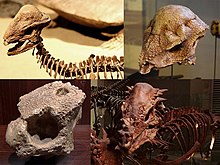| Pachycephalosaurs Temporal range:
| |
|---|---|

| |
| Montage of four pachycephalosaurs. Clockwise from top left: Stegoceras, Prenocephale, Pachycephalosaurus and Homalocephale | |
| Scientific classification | |
| Domain: | Eukaryota |
| Kingdom: | Animalia |
| Phylum: | Chordata |
| Clade: | Dinosauria |
| Clade: | †Ornithischia |
| Clade: | †Neornithischia |
| Clade: | †Pyrodontia |
| Clade: | †Cerapoda |
| Clade: | †Marginocephalia |
| Clade: | †Pachycephalosauria Sternberg, 1945 (conserved name) |
| Type species | |
| †Pachycephalosaurus wyomingensis Gilmore, 1931 (conserved name)
| |
| Genera | |
| |
Pachycephalosauria (/ˌpækɪsɛfələˈsɔːriə, -ˌkɛf-/;[2] from Greek παχυκεφαλόσαυρος for 'thick headed lizards') is a clade of ornithischian dinosaurs. Along with Ceratopsia, it makes up the clade Marginocephalia. With the exception of two species, most pachycephalosaurs lived during the Late Cretaceous Period, dating between about 85.8 and 66 million years ago.[3] They are exclusive to the Northern Hemisphere, all of them being found in North America and Asia. They were all bipedal, herbivorous/omnivorous animals with thick skulls. Skulls can be domed, flat, or wedge-shaped depending on the species, and are all heavily ossified. The domes were often surrounded by nodes and/or spikes. Partial skeletons have been found of several pachycephalosaur species, but to date no complete skeletons have been discovered. Often isolated skull fragments are the only bones that are found.[4]
Candidates for the earliest-known pachycephalosaur include Ferganocephale adenticulatum from Middle Jurassic Period strata of Kyrgyzstan and Stenopelix valdensis from Early Cretaceous strata of Germany, although R.M. Sullivan has doubted that either of these species are pachycephalosaurs.[5] Albalophosaurus from the Early Cretaceous strata of Japan might also represent a basal pachycephalosaur.[1] The oldest known definitive pachycephalosaur is Sinocephale bexelli from the Late Cretaceous of China.[6] In 2017, a phylogenetic analysis conducted by Han and colleagues identified Stenopelix as a member of the Ceratopsia.[7]
- ^ a b c Fonseca, A. O.; Reid, I. J.; Venner, A.; Duncan, R. J.; Garcia, M. S.; Müller, R. T. (2024). "A comprehensive phylogenetic analysis on early ornithischian evolution". Journal of Systematic Palaeontology. 22 (1). 2346577. doi:10.1080/14772019.2024.2346577.
- ^ "Pachycephalosauria". Oxford Dictionaries UK English Dictionary. Oxford University Press.[dead link]
- ^ Cite error: The named reference
:0was invoked but never defined (see the help page). - ^ Cite error: The named reference
:1was invoked but never defined (see the help page). - ^ Sullivan 2006 [verification needed]
- ^ Evans, David; Brown, Caleb M.; You, Hailu; Campione, Nicolás E. (2021). "Description and revised diagnosis of Asia's first recorded pachycephalosaurid, Sinocephale bexelli gen. nov., from the Upper Cretaceous of Inner Mongolia, China". Canadian Journal of Earth Sciences. e–First (10): 981–992. doi:10.1139/cjes-2020-0190. S2CID 244227050.
- ^ Han, F.-L.; Forster, C.A.; Clark, J.M.; Xu, X. (2016). "Cranial anatomy of Yinlong downsi (Ornithischia: Ceratopsia) from the Upper Jurassic Shishugou Formation of Xinjiang, China". Journal of Vertebrate Paleontology. 36 (1): e1029579. doi:10.1080/02724634.2015.1029579. S2CID 130791053.